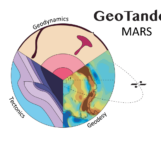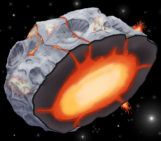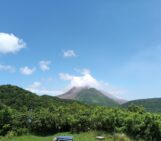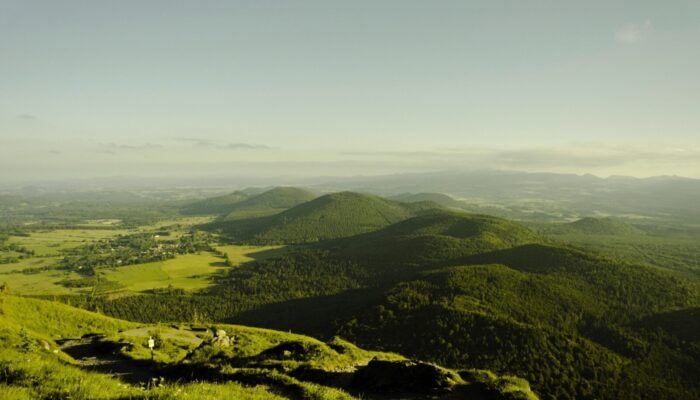
Continental rifts are a striking manifestation of the forces at work in the Earth’s interior and are often associated with volcanic activity. Contrary to intuition, volcanism is not confined to rift grabens, but migrates as the rifts evolve. How and why this happens is still not clear. This week, Gaetano Ferrante from Rice University, Houston (USA) will share his research with us, showing how the interplay of tectonic stretching, rift deepening and sedimentation may solve the mystery.

Gaetano Ferrante is a Ph.D. candidate in Earth, Environmental and Planetary Science at Rice University, Houston (USA). His research focuses on investigating the dynamics of volcanoes through numerical modelling of deep magma transport, with an eye of regard for Kilauea Volcano, Hawaii. On the side, he also runs rheology experiments to study the role of bubbles on the viscosity and outgassing properties of magmas. His contact and more information could be found at https://gaetanoferrante.com/.
From the high peaks punctuating the East African plateaus to the hilly landscape of the French Chaîne des Puys, volcanism is an integral constituent of continental rifts, yet still a debated one. While geodynamic models can simulate the flow of the mantle and the deformation of crustal rocks occurring during the history of rifts, they often fail to reproduce the distribution of volcanism associated with their evolution.
Volcanism in rifts has often been observed to migrate from the rift graben to its flanks and vice versa, and large volumes of horizontally intruded magma have been repeatedly imaged beneath most of the Earth’s best-studied rifts (Figure 1), but the controls on these patterns are still unclear. At the heart of this discrepancy are the very different timescales over which the two processes occur. While large-scale deformation of the lithosphere due to tectonic forces unfolds over millions of years — over which the solid Earth flows like a viscous fluid — magma propagation takes place in a matter of hours to weeks, resulting in brittle behaviour of lithospheric rocks.
Magma transport through the lithosphere occurs mostly through dyking, a form of hydraulic fracturing. Being predominantly opening fractures, dykes tend to open roughly in the direction of least compression, and their ascent pathways are therefore sensitive to the stress field in the lithosphere. Through field observations, laboratory experiments, and numerical modelling, the trajectories followed by dykes during their ascent to the surface have been observed to be strongly influenced by topographic loads. In particular, as clearly shown by analogue models, hydraulic fractures propagating in elastic media tend to be attracted by surface loads (such as mountain ranges or volcanoes in nature) and deflected by unloading conditions (such as deglaciation or crustal thinning), and field observations of exposed dykes confirm such trends.
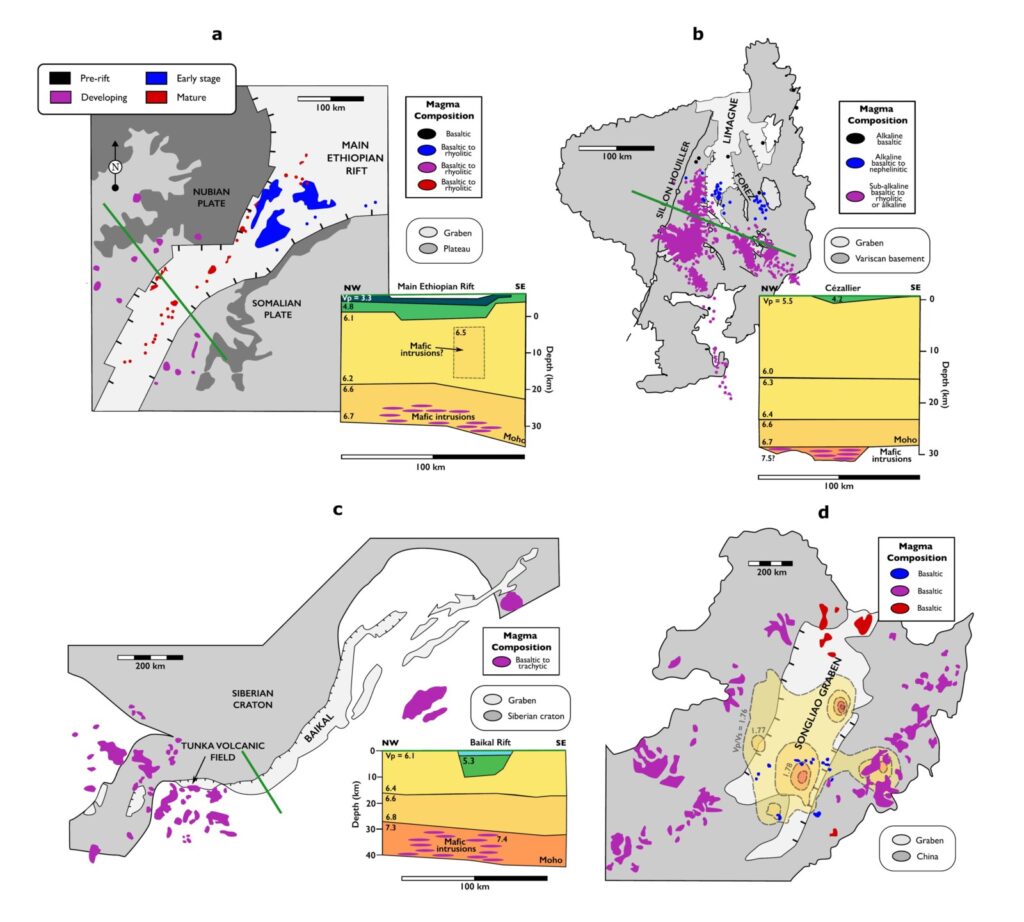
Figure 1: Examples of observations of the spatio-temporal evolution of rift magmatism from (a) the Main Ethiopian Rift, (b) the Limagne Graben, France, (c) the Baikal Rift, Russia and (d) the Songliao Basin, China. Insets show crustal velocity profiles to highlight the presence of lower crustal horizontal intrusions. After Ferrante et al., 2024.
Maccaferri et al. (2014) applied this concept to continental rifts to explain why volcanic centres often occur on the flanks of rift grabens rather than in the graben itself, an observation that had long struck geologists as counterintuitive. For example, volcanic centres associated with the Baikal Rift, Russia, almost exclusively occur on its rift shoulders, while no significant volcanism has ever taken place in the 10 km deep rift depression. To explain this phenomenon, Maccaferri and colleagues modelled the rift excavation as a strip of unloading forces acting over the surface of an elastic half-space, to which they superimposed a horizontal tectonic stretching (Figure 2a). They numerically simulated magma propagation in the resulting stress field by considering dykes as pressurized fractures filled with a buoyant, inviscid fluid (Figure 2a). They found that the problem is controlled by two parameters: the tectonic tensile stresses and the unloading pressure, which is a function of the graben depth. When the unloading pressure dominates over the tectonic stresses a “stress barrier” appears under the rift. This is an area where the direction of least compression becomes vertical so that dykes coming from depth are deflected as they ascend, eventually reaching the surface outside the rift basin (Figure 2b).

Figure 2: a) Geometry used in the numerical simulations of Maccaferri et al., 2014 illustrating the strip unloading method for calculating the stress field due to a rift graben. b) Simulation results from Maccaferri et al., 2014 showing the shape and extent of the stress barrier (red shaded area) and its effect on ascending dykes. Modified after Maccaferri et al., 2014.
While the model developed by Maccaferri et al. (2014) provided a solid, physics-based explanation for the counter-intuitive occurrence of volcanic centres on rift shoulders, it also prompted an additional question: could similar processes also be responsible for the rather sudden shifts in the location of volcanism occurring in worldwide rifts (such as the Main Ethiopian Rift and the Limagne Graben) throughout their histories?
In a recently published paper (Ferrante et al., 2024), we have extended the Maccaferri model to investigate whether the observed patterns of volcanism in rifts can be attributed to the redistribution of surface loads during the development of the graben. We have modelled the deepening of the rift basin as a gradually increasing unloading strip acting over the surface of an elastic half-space, to which we have superimposed a gradually thickening loading strip simulating sediment accumulation and a horizontal tectonic stretching. At periodic timesteps, we have let dykes propagate in the resulting stress field, to observe their trajectories and surface arrivals at different stages of rift evolution.

Figure 3: The four stages of rift-related volcanism identified in our simulations. a: Early scattered in-rift volcanism. b: Off-rift volcanism and sill formation. c: Sill stacking and off-rift volcanism. d: Late axial in-rift volcanism. Upper panels: Bold line represents rift topography. Sedimentary layer is patched in yellow. Colored triangles mark the locations of surface dyke arrivals. Lower panels: Density plots of dyke emplacements. Colored crosses indicate the coordinates at which dykes are injected. After Ferrante et al., 2024.
The results of our simulations reveal four main stages in the development of rift volcanism (Figure 3):
- At first, when the rift is not very deep, dykes ascend sub-vertically toward the surface of the basin, resulting in scattered in-rift eruptions.
- As the rift deepens, the unloading pressure due to the excavation of the basin dominates over the tectonic stretching, and a stress barrier is formed, which deflects ascending dykes towards the flanks of the depression, resulting in off-rift arrivals.
- If the stress barrier extends beyond the dyke injection depth, dykes that are injected too close to the rift axis may lack the buoyancy needed to ascend and get trapped as sill-like structures in the lower crust. These horizontal intrusions can in turn serve as progressively shallower magma ponding zones from where subsequent dykes are injected, promoting the stacking and piling of the sills under the rift.
- Eventually, the shallowing of the injection depth will result in a later stage where dykes are injected from above the stress barrier and volcanism shifts back to the axial part of the rift.
The promising agreement between our results and the available observations suggests that the redistribution of surface loads on an elastic crust during rift development, due to graben deepening and sedimentation, can exert a major control on the spatio-temporal evolution of volcanism in continental rifts. This highlights the importance of surface processes in determining whether and where magma will erupt or stall, with strong implications for the forecast of magma pathways and eruptive vent locations in rifts and for the formation of mineral systems.
References: [1] Maccaferri, F., Rivalta, E., Keir, D., & Acocella, V. (2014). Off-rift volcanism in rift zones determined by crustal unloading. Nature Geoscience, 7(4), 297-300. https://doi.org/10.1038/ngeo2110 [2] Ferrante, G., Rivalta, E., & Maccaferri, F. (2024). Spatio-temporal evolution of rift volcanism controlled top-down by a deepening graben. Earth and Planetary Science Letters, 629, 118593. https://doi.org/10.1016/j.epsl.2024.118593

